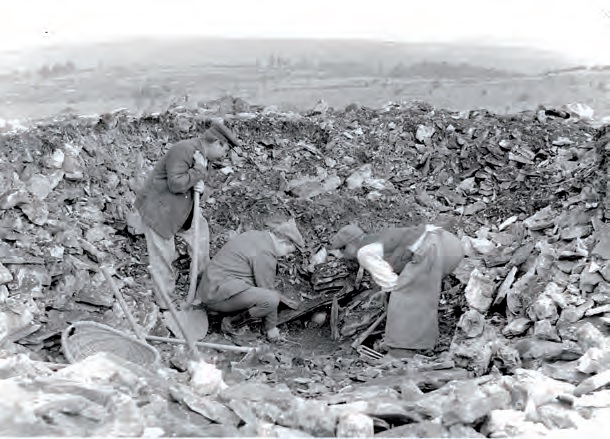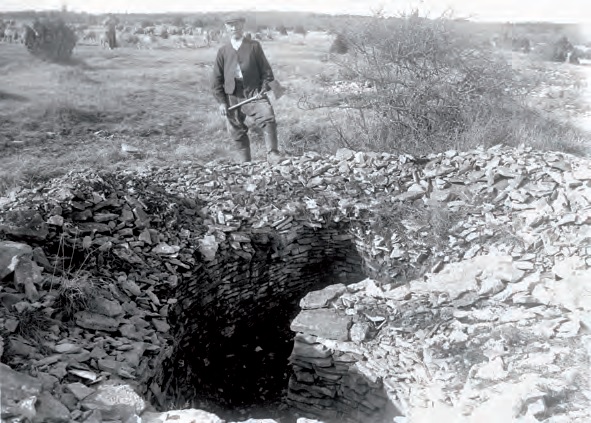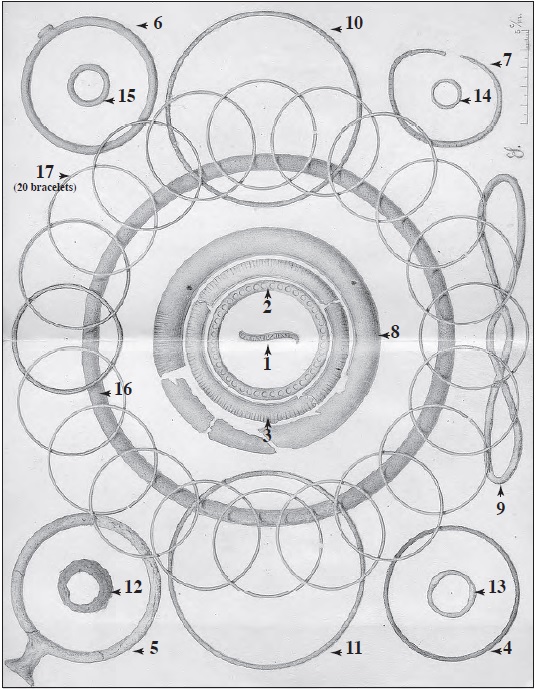Tumulus of the Rente-Neuve
Publié 17/10/2018 16:59:05 Modifier 11/07/2019 09:58:29 par 489945901
The tumulus is hardly perceptible, about thirty meters from a path that connects the villages of Couchey and Flavignerot near the farm Rente-Neuve.
#History #Tumulus #Hallstatt #Couchey #Flavignerot Period: -1600 to -300 years.
Situation and current status
The tumulus is hardly perceptible, about thirty meters from a path that connects the villages of Couchey and Flavignerot.
It is located near the farm Rente-Neuve and one kilometer southeast of the southern tip of Mont-Afrique.
At the end of the 19th century, most of the agricultural lands in this area were covered with fallow pastures and pastures ( oral information provided by G. Aubry ).
Currently, the land is cultivated or wooded.
Ten years ago, the tumulus bore traces of ancient excavations.
Unfortunately, because it was an embarrassing eminence for cultivation, it was fully leveled in the early 1990s.
Its diameter was 30 m and its height was 1.60 m. It is close to two small mounds, excavated in 1938 by E. Guyot, barely visible nowadays.
History of excavations
This study presents only the furniture and description of the tumulus first explored in the late nineteenth century by M. Golotte.
It was explored methodically a second time, twenty-five years later by E. Bertrand, R. Bouillerot and É. Socley.
Excavations were carried out every Sunday from April 1921 to May 1928.
Arranged on the remains of a ( anterior? ) Construction, five Middle Bronze Age ( Cenotaph ) tombs have been found, aligned one against the other in the center of the mound ( Ratel, 1961; Nicolardot, 2003, see inventories on page 325 ).
Around them, there were about twenty adventitious burials containing furniture datable of the first ( final Hallstatt ) and the second Iron Age (the old Tene ).
The limits of the excavations of the tumulus, in its southern part, were not reached, because it was impossible for the excavators to evacuate their excavations on the cultures around the monument.
The materials were rejected on the structures already explored.
These different researches show that the hillock was built using limestone blocks of small and medium size.
The report was briefly published in 1925 ( Bertrand et al., 1925 ), but it was R. Ratel, who in 1961 made it the first major publication, devoted primarily to the latest research ( Ratel, 1961 ) .
However, the furniture from the excavations, designed by E. Socley, has not been described by Roger Ratel.
That's why we decided to publish it.
Around 1896, Mr. Golotte performed two funneling " excavations " of a depth of 0.80 m on the summit and the western edge of the tumulus.
The excavations were thrown on the edge of the excavations, as was customary at that time.
The Dijon archaeologist É. Socley, probably present during the first picks on the funeral mound, photographed the main stages of the excavations.
Indeed, among his photographic archives preserved in the Archaeological Museum of Dijon, appear three unpublished photographs that we reproduce here.
One ( Fig. 3, No. 1 ) shows three diggers standing, with an imposing burial mound made of limestone in the background, similar to that of the Rente-Neuve.
There is still some doubt: is it the same tumulus, or do we find ourselves in the presence of another mound?
However, its natural environment seems identical to that described above ( wastelands, sheep pastures ).
On the second photograph ( fig.3, n ° 2 ) the same diggers ( in the middle Mr. Golotte? ) Have " cratered " the top of the mound.
Finally, on the last shot ( Fig. 3, No. 3 ), there is an additional excavation.
This is probably the second sounding mentioned by R. Ratel to the west of the funerary monument ( Ratel 1961: 177 ).
Evidently, excavations, carried out in the spirit of the nineteenth century, had the main interest, in the eyes of the excavator, to exhume " beautiful " objects.
Research completed, É. Socley recovered the bone remains left by Mr. Golotte on the edge of the mound. He estimates at four the number of skeletons exhumed.
None of the objects reported can now be attached to a burial. Two fibules of the final Hallstatt, fragmented, double timpani of the Type dp4 of Mansfeld ( Ratel, 1961, p.188 , Fig. 67 ), werefound by É. Socley in the digs of the diggers.
Photographs of the excavations of the tumulus of the Rente-Neuve (against plate-type, Archaeological Museum of Dijon).
Fig.3, No. 1

Fig.3, No. 2

Fig.3, No. 3
Structure
The mound massif consisted of a mass of local stones with a large number of flat slabs laid flat on several rows superimposed.
furniture

Fig. 4.
Furniture from La Rente-Neuve discovered by M. Golotte (drawing É. Socley, after RATEL, 1961).
Furniture from La Rente-Neuve discovered by M. Golotte (drawing É. Socley, after RATEL, 1961).
A fragment of bronze bracelet of rectangular section; decoration of vertical striations separated by incisions in cross ( n ° 1 ). Middle-final Hallstatt.
A closed bronze bracelet full of rectangular section worn on the side edges; decoration of circles pointed on two sides ( n ° 2 ). This bracelet is comparable to the copies of the final Hallstatt in Côte-d'Or: Darcey, tumulus of the "Combe Barré" ( Maranski, 1992, page 158, page 11, figure 2 ); Magny-Lambert, tumulus of "Montceau-Milon" ( idem, 61, Fig. 7 ); Minot, tumulus of the "Guéret aux hares" ( ibidem, page 238, page 41, figure 5 ).
A fragmented hollow bronze bracelet; interlocking closure; decoration of fine transverse striations ( n ° 3 ). Hallstatt fi nal.
A filiform bracelet in solid bronze of circular section ( n ° 4 ). Hallstatt final.
A closed bronze bracelet full of circular section; casting stream left in the rough ( No. 5 ). The "Clair Bois" tumulus at Bressey-sur-Tille ( Ratel, 1977 ) delivered a similar type of adornment ( Chaume, 1999, figure 9, AI ). The old Tene.
A closed bronze bracelet full of circular section; a protuberance marks the location of the casting stream ( No. 6 ). La Tène ancienne ( Chaume, 1999, pp. 518, Fig. 12, A1-2 ).
An open oval bracelet in solid bronze with circular section ( n ° 7 ). Middle-final Hallstatt.
A closed leg ring very worn and fragmented hollow bronze; decoration of thin transverse streaks erased ( n ° 8 ). Hallstatt final.
A ring ( of leg? ) Closed in solid bronze of round section voluntarily folded in "helix" ( n ° 9 ). This object is too common to be the subject of a chronological attribution, but its deformation raises question.
Two smooth bronze leg rings full of circular section ( Nos. 10, 11 ). Hallstatt final.
An iron ring ( No. 12 ). This object is too common to be chronologically assigned.
Three bronze rings ( Nos. 13, 14, 15 ). These objects are also too common to be chronologically assigned.
A closed smooth torque in solid bronze of circular section ( n ° 16 ). Hallstatt final.
Twenty filiform bracelets in solid bronze ( n ° 17 ). Hallstatt final. Place of deposit of furniture: Archaeological Museum of Dijon. Most of the material attributed to this tumulus comes from the middle-final Hallstatt and extends slightly beyond the Second Iron Age.
Place of deposit of the furniture: Archaeological Museum of Dijon. The material attributed to this tumulus falls in the majority of Hallstatt medium-final and overflows slightly on the second Iron Age.
Electronic reference
Jean-Pierre Devaux, " The protohistoric environment of Mount Africa: unpublished data on tumulus excavations carried out in the late nineteenth century. and in the early 20th century. in Couchey (Côte-d'Or) », Archeological Review of the East, Volume 56 | 2007, posted on February 20, 2009, accessed on November 16, 2015.
Author
Jean-Pierre Devaux, amateur archaeologist, 21 rue de la Combette, hamlet of Domois, 21600 Fenay, © All rights reserved.
Link to the original electronic documents:
https://rae.revues.org/5236
Location +/- 4 meters.